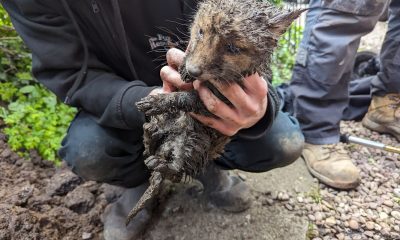Scientists say this is why giraffes grew long necks
The longer the neck, the greater the damage to the opponent.
Published
2 years ago onBy
Talker NewsBy Stephen Beech via SWNS
The giraffe grew its long neck for head-butting battles with love rivals, according to a new study.
Scientists say they needed them for head-banging combat in competition for mates rather than for reaching for food in tall trees.
An analysis of an early giraffe ancestor’s unique head and neck fossils – disk-shaped helmet-like headgear and highly complex head-neck joints – suggests an alternative explanation for the evolution of modern giraffes’ long necks.
The characteristic neck of the modern giraffe – the tallest land animal and largest ruminant on Earth – has long been considered a classic example of adaptive evolution and natural selection since Charles Darwin first penned the concepts.
It’s commonly believed that competition for food drove neck elongation and allowed giraffes to browse for treetop leaves in the African Savannah woodlands that were well outside the reach of other ruminants.
However, others have argued a “necks-for-sex” hypothesis, suggesting sexual selection driven by competition among males may have also contributed to neck evolution.
It was the discovery of strange fossils, dated to roughly 17 million years ago, that revealed the key driving forces in giraffe evolution, according to the Chinese research team.
As observation of giraffe behavior increased, scientists began to realize that the long neck of giraffes actually serves as a weapon in male courtship competition and that may be the key to the giraffe evolutionary mystery.
The longer the neck, the greater the damage to the opponent.
Researchers from the Institute of Vertebrate Paleontology and Paleoanthropology (IVPP) of the Chinese Academy of Sciences conducted their study on Discokeryx xiezhi, a strange early giraffoid.
The fossils analyzed in the study, published in the journal Science, were found in early Miocene strata from about 17 million years ago on the northern margin of the Junggar Basin, Xinjiang. A full skull and four cervical vertebrae were part of the find.
Corresponding author Professor Deng Tao, of IVPP, said: "Discokeryx xiezhi featured many unique characteristics among mammals, including the development of a disc-like large ossicone in the middle of its head."
He explained that the single ossicone resembles that of the xiezhi, a one-horned creature from ancient Chinese mythology - giving the fossil its name.
Prof. Deng said that the cervical vertebrae of Discokeryx xiezhi are very stout and have the most complex joints between head and neck and between cervical vertebrae of any mammal.
The team demonstrated that the complex articulations between the skull and cervical vertebrae of Discokeryx xiezhi was particularly adapted to high-speed head-to-head impact.
They found the structure was far more effective than that of extant animals, such as musk oxen, that are adapted to head impact. In fact, Discokeryx xiezhi may have been the vertebrate best adapted to head impact ever.
Study first author Dr. Wang Shiqi said: "Both living giraffes and Discokeryx xiezhi belong to the Giraffoidea, a superfamily.
"Although their skull and neck morphologies differ greatly, both are associated with male courtship struggles and both have evolved in an extreme direction."
The research team compared the horn morphology of several groups of ruminants, including giraffoids, cattle, sheep and deer.
They found that horn diversity in giraffes is far greater than in other groups, with a tendency toward extreme differences in morphology, indicating that courtship struggles are more intense and diverse in giraffes than in other ruminants.
The research team further analyzed the ecological environment of Discokeryx xiezhi and the niche it occupied.
They said that Earth was in a warm period and generally densely forested, but the Xinjiang region, where Discokeryx xiezhi lived, was drier than other areas because the Tibetan Plateau to the south had been rising dramatically, blocking the transfer of water vapor.
Co-corresponding author Dr. Meng Jin said: "Stable isotopes of tooth enamel have indicated that Discokeryx xiezhi was living in open grasslands and may have migrated seasonally.
"For animals of the time, the grassland environment was more barren and less comfortable than the forest environment.
"The violent fighting behavior of Discokeryx xiezhi may have been related to survival-related stress caused by the environment."
The researchers said that at the beginning of the emergence of the genus Giraffa, a similar environment existed. Around seven million years ago, the East African Plateau also changed from a forested environment to open grassland, and the direct ancestors of giraffes had to adapt to new changes.
Prof Deng said: "It is possible that, among giraffe ancestors during this period, mating males developed a way of attacking their competitors by swinging their necks and heads.
"This extreme struggle, supported by sexual selection, thus led to the rapid elongation of the giraffe's neck over a period of two million years to become the extant genus, Giraffa."
He added: "Based on this elongation, Giraffa were well-suited for the niche of feeding on high foliage.
"However, their ecological status was necessarily less secure than that of bovids and cervids.
"As a result, Giraffa's marginal ecological niche may have promoted extreme intraspecific courtship competition, which in turn may have promoted extreme morphological evolution."
Stories and infographics by ‘Talker Research’ are available to download & ready to use. Stories and videos by ‘Talker News’ are managed by SWNS. To license content for editorial or commercial use and to see the full scope of SWNS content, please email [email protected] or submit an inquiry via our contact form.
You may like


Rare condition that stunts growth also reduces heart attack risk


Research reveals mice think just like human babies


Harvard study reveals how pollution raises risk of heart attack or stroke


Does taking the stairs instead of an elevator help you live longer?


Dog theft causes same emotional turmoil as losing a child: study


Invasive lionfish colonized Mediterranean in just a decade
Other Stories


Adorable dog kicks his leg while he walks
A video captured the pup bouncing along the street of his native China.


Woman’s with rare ‘Sleeping Beauty’ condition sleeps every four hours
She was diagnosed at age 18 after years of struggling to stay awake in school and nodding off during class.


97-year-old veteran receives WWII service medal 80 years later
"We’re all so proud of Eve."


Fox cub saved by plumbers after getting stuck underground
The little mammal was trapped inside a four-inch-wide pipe.


Rare condition that stunts growth also reduces heart attack risk
Scientists believe that drugs that cause similar effects could reduce the risk of a heart attack or stroke.
Top Talkers

 Parenting1 week ago
Parenting1 week agoSingle mom details struggles of feeding her 12 kids

 Lifestyle1 week ago
Lifestyle1 week agoWoman regrets her tattoo nightmare: ‘It’s horrendous’

 Wildlife3 days ago
Wildlife3 days agoClever elephant returns visitor’s shoe that fell into enclosure

 Good News4 days ago
Good News4 days agoDisabled student takes first steps in 10 years on graduation stage

 Health4 days ago
Health4 days agoNew study reveals ‘old age’ begins later than it used to

 Entertainment1 day ago
Entertainment1 day agoWhat is the perfect movie length?

 Work2 days ago
Work2 days agoHow much does your workspace affect productivity?

 Travel4 days ago
Travel4 days agoOne-fifth of Americans think about their next vacation while still on vacation

